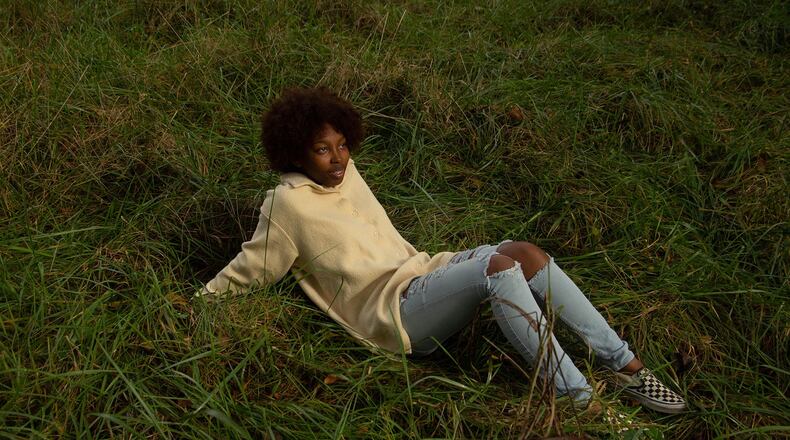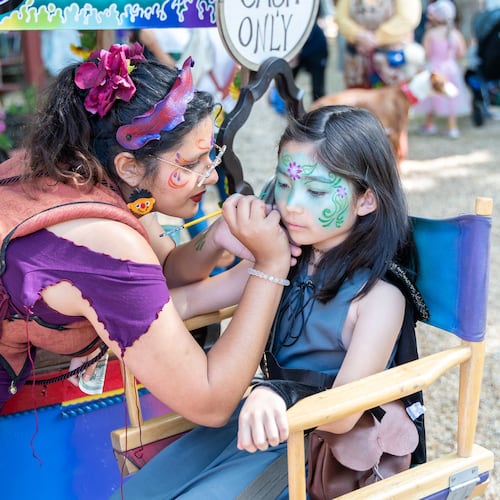Spending time in artist Taylor Janay Manigoult’s company is like tapping into the essence of youth: the promise, the anxiety, the churning ideas, the edge-of-the-earth sensation you forget comes with being 25 and on the cusp. Add to that being Black, nonbinary and living in a time of incredible tumult in America. Now, spend a year and a half at home. To be young in 2021 in America is very, very complicated.
The winner of this year’s Edge Award presented by the Forward Arts Foundation to honor emerging and mid-career artists, Taylor Manigoult produces work that is as complex as the thoughts swirling around in the artist’s brain. The award comes with an April 2022 solo exhibition at Swan Coach House Gallery, $10,000 and a two-week residency at the Hambidge Center. It also represents the recognition by an arts organization composed of Atlanta elites of the singular talent of an artist who defies boundaries and easy categorization.
On a recent Saturday afternoon in the tidy, historic College Park bungalow where Manigoult (who uses the pronouns they and them) lives, our conversation encompasses a remarkable array of topics inspired by what Manigoult has been reading and thinking about: the inextricable association of femininity with whiteness in American culture; Alice Walker’s “The Temple of My Familiar”; political and intellectual liberation; Frank B. Wilderson’s groundbreaking book “Afropessimism”; Alexis Pauline Gumbs’ Black feminist poetry collection “Spill”; Vanderbilt scholar and literary critic Hortense Spillers; jazz composer Sun Ra; and Black science fiction writer Octavia E. Butler’s “Parable of the Sower.”
Credit: Jessica Vass
Credit: Jessica Vass
Like other artists of their generation, Manigoult is not limited by boundaries of identity, gender and mediums. They have embraced photography, film, installation art, poetry and art criticism with an ambition that seems boundless.
“A lot of students in BFA programs are making work that is sort of an homage to someone who inspired them,” says Atlanta photographer Jill Frank, who taught Manigoult in the BFA program at Georgia State University. “And that’s not something I experienced with Taylor’s work.”
For Frank, Manigoult’s work has “a very, very unique perspective that felt fresh,” she says. Their artwork is “unafraid to tackle subjects that are vulnerable. And, you know, to think big, and to take risks and experiment and try.”
Manigoult’s childhood was spent roaming the forests and open spaces of Johns Creek before development changed that wonderland landscape. They associate their earliest memories of liberation with exploring the neighborhood’s mysteries and remembers the fear but also exhilaration of being lost in the wild.
Having grown up one of four children in a family that encouraged creativity, Manigoult was 9 when she wrote and performed a poem on the occasion of her aunt’s retirement from the police department. Overcome with emotion, Manigoult remembers crying, caught up in the moment.
Manigoult’s mother encouraged them to take a drawing class in high school. Manigoult also explored photography, in addition to pursuing an ongoing love of poetry. Those interests eventually paved the way to Virginia Commonwealth University where Manigoult met New Orleans-based artist Malcom Peacock.
“Taylor and I met at a party at an old friend’s place in Richmond, Virginia. I think being Black kids, who weren’t really fleshed out adults yet, in an all white environment helped us just easily gravitate towards each other,” says Peacock.
“Taylor is extremely self reflective and interrogative,” says Peacock. “But something really unique about them is how gentle they are with themselves and others. And this is not typical in our world’s harsh capitalist training. They approach everything with deep compassion.”
Credit: Handout
Credit: Handout
In Manigoult’s delicate, melancholy short film “Ahmad’s Street,” Manigoult appropriates archival images from “Palmour Street: a Study in Family Life” made by the Georgia Department of Public Health in 1951 of a Black family in Gainesville. The vignettes they pulled ache with fleeting joy and sweetness. They are intercut with found footage of chaotic jitterbugging musical numbers from the 1941 Universal film “Hellzapoppin.’” The result is a poetic meditation on the intimate life of a family and also the more public and performative side of Black representation in Hollywood.
It’s an incredibly moving work of art for how it conveys the gentle, hidden beauty of family life, especially in a world where such softness and tenderness is so rarely allowed Black subjects. The piece is remarkably sophisticated and seems to relate, like so much of Manigoult’s work, to the artist’s own sense of vulnerability and trauma.
“It’s a movie that really documents or illustrates the importance of caring for the mental health of your children,” Manigoult says.
But nothing feels like experimentation just for the sake of it in Manigoult’s embrace of so many different mediums. In fact, Manigoult is quite deliberate in weighing how a particular medium — whether a poem, photograph or film — will best convey an idea.
“I try to be intentional,” Manigoult says. “And I just put myself under a lot of pressure to make sure that the reason I’m using that medium will speak to the concept that I’m trying to push.”
In a 2020 collaborative work Manigoult made with artist Amber Bernard for a one-night exhibition at the Goat Farm, “Flowers Within Reach,” Manigoult shows the spare, elegant, often enigmatic expression that often characterizes their work. A tub of water is placed next to a mound of daffodils arranged on a mound of dirt, sentinels of spring that we know will die without a drink.
Credit: Taylor Manigoult
Credit: Taylor Manigoult
At the opening for the installation, Manigoult read the poem “Leaves of Grass” by 2018 National Book Award in Poetry winner Justin Phillip Reed. “In my head, it’s about the world ending as you’re living in it,” Manigoult says of Reed’s poem.
After the show, Manigoult was adamant about making sure the daffodils were replanted. “Because we felt it’d be kind of backwards to be talking about environmental destruction and then destroying things,” Manigoult says. “You know, you always have to give back once you take.”
Such tossed-off observations can stop listeners in their tracks, like Manigoult’s pronouncement, “I make work about my experience of living and dying and living.”
There is a heavy weight on Manigoult’s shoulders, and they often seem too delicate to bear it, as when Manigoult describes the influence of Afropessimism and the sense of futility in changing the reality of race relations in America.
“The identity of Blackness was born at the same time as slavery,” Manigoult says. “There’s no separation between the two. There’s no Blackness without slavery. So any fight for Black human rights will not succeed, because under this framework, you cannot be Black and be a person at the same time, ideologically.”
Black people have been robbed of their personhood, Wilderson proposes in “Afropessimism.” And what art does — poetry and science fiction, performance and critical theory, photography — is restore it and affirm that personhood is undeniable.
For Manigoult, like the authors they admire, art is an assertion of self.
“I found a place where I could imagine possible futures, a place where life could be lived differently,” says Manigoult. One image. One poem. One film at a time. “I’m excited to see what comes next.”
About the Author
The Latest
Featured





